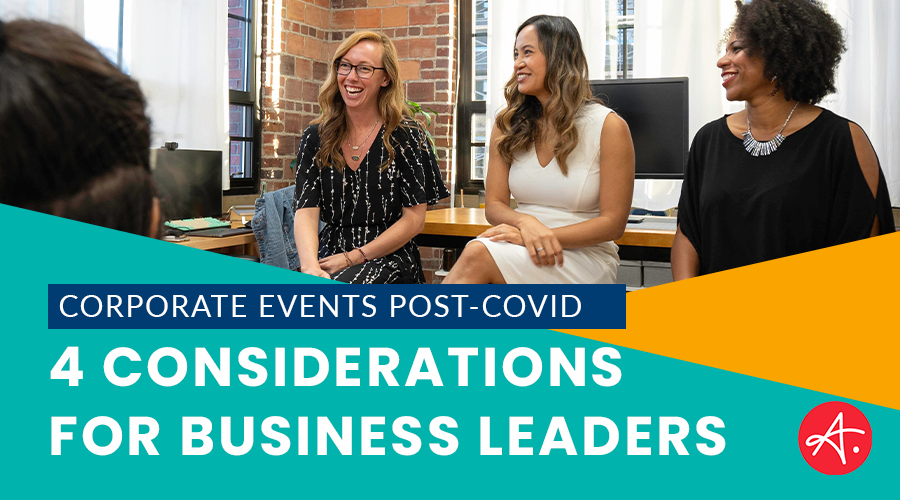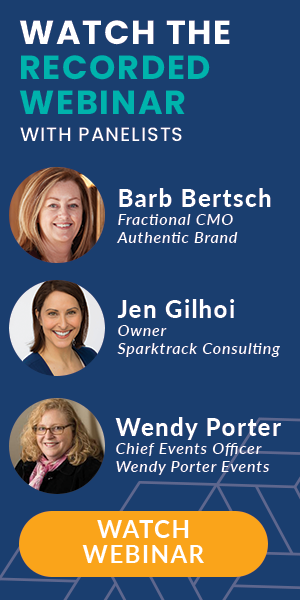
Many of the businesses we work with at Authentic have long relied on traditional, paid corporate events to increase brand awareness and support business development efforts. Nearly every Authentic client has (or had) a line item for events on their budget.
The future of corporate events and their role in a company’s marketing strategy got thrown into question in March 2020 when the COVID-19 pandemic halted all travel and in-person events. Some businesses quickly, nimbly, and effectively pivoted in-person events to virtual ones, while others canceled their participation in events altogether. Today, as the world begins to return to its new normal, businesses question if and how best to re-incorporate events into their marketing plans.
Considerations for the post-2020 event landscape
Corporate events have always been tricky, but today’s event landscape is a whole new world. Sudden virtual shifts have created new opportunities for broader engagement and have reshaped the event attendee experience. Live events are re-emerging, but they require a more complex mix of blended in-person and virtual experiences. Safety, access, and value are converging to reshape requirements and expectations.
The event landscape is still in a very fluid state, requiring businesses to evaluate how they can confidently take advantage of new opportunities while also being good stewards of their resources and relationships. Companies should consider the following trends to determine how best to leverage the changed corporate event landscape to build awareness, generate interest, and expand their businesses.
1. New emerging event strategies
The COVID-19 pandemic forced the world to shift to an exclusively virtual experience, creating a new world for corporate events. New event strategies have emerged that will likely continue to alter the future of events. Virtual events changed how we think about the data and insights we gather from events, how we market events, and how we best engage attendees before and after events.
Jen Gilhoi, an Authentic Ally Network provider and events communication strategist, summarized new event strategies well;
“What virtual has shared with us are data and insights that provide a richness that we can learn from and take forward to fuel what that next engagement with your audience is. Before COVID, companies typically gave very little thought to pre-and post-event engagement. Now we’re thinking more about engaging attendees before and after the event, with data and insights to guide us.
Virtual has also improved access to events significantly, often tripling or quadrupling the number of attendees. There are now opportunities to build more intimately connected event communities and nurture them long after the event ends on digital platforms like Slack, Clubhouse, and LinkedIn groups.”
Jen Gilhoi
Owner | Sparktrack Consulting
2. Event technology continues to evolve
Even before the COVID-19 pandemic, companies were investing in event technology innovation. Event organizers were ditching traditional, printed event brochures in favor of event apps that streamline communication and enable attendees to connect more effectively. High-quality streaming video and live polling were becoming more prevalent. COVID-19 accelerated the adoption of event technology by creating a new environment and increasing attendees’ expectations for how technology can support their event experience.
Wendy Porter, another Ally Network provider and corporate events strategist, reflected recently on the event technology trends driven by the pandemic:
“Today, there are 340 different virtual event platforms, including StreamYard, vMix, twine, and MURAL. The platforms are typically either broadcast technology, which requires a similar approach that you would use if producing content for a TV show, or they’re a Zoom-like platform that enables collaboration. There isn’t a platform yet that does both of these things well. As a result, I’ve seen production companies cobbling the two platform types together. They want the quality and branding that a broadcast platform enables, but they also want the engagement that a platform like Zoom supports. Technologists have been marrying these two product types together, so the end-user isn’t typically aware that they’re switching between platforms.
Today’s virtual and hybrid event formats require companies to think even more about engagement and how Internet speeds and equipment quality, like cameras, microphones, and lighting, can impact it. Trade show technology like 3D exhibit halls don’t facilitate engagement well on their own, so sponsors must creatively think about engagement beyond creating the booth itself.”
Wendy Porter
Chief Events Officer | Wendy Porter Events
3. Reshaped human expectations and values
The COVID-19 pandemic has radically reshaped people’s expectations for in-person versus virtual experiences. Many professionals have discovered new freedom and flexibility that comes with remote or hybrid work, questioning the amount of time we used to spend commuting, traveling, and attending events far from home.
Companies must consider how their audiences’ norms and values have changed in this new world and how it impacts how they show up and participate in events. For certain audiences, this may mean virtual events are the norm from now on. Other audiences may require a hybrid event environment, offering in-person experiences for those who crave in-person connection again while simultaneously providing a virtual experience for those who can’t or prefer not to travel. Regardless, companies must consider how they ensure attendee engagement in either event format.
Barb Bertsch, an Authentic Fractional CMO, shared her thoughts on new event expectations:
“As things start to reopen and people start to re-engage in person, some will find value in those in-person interactions again, but I’m not sure everyone will. There are multiple reasons people don’t attend in person, whether personal, professional, or financial. The online event offering is going to be a game-changer for event hosts and sponsors if they successfully figure out how to engage attendees in virtual and hybrid environments.”
Wendy added, “Think about the five senses when designing a virtual experience. Send attendees a gift box with a treat to eat (taste) or a custom scent (smell). Ensure the quality of sound. Even if people are attending virtually, there are still ways to activate the five senses, which play a significant role in aiding engagement and helping people remember the experience of the event.”
Barb Bertsch
Fractional CMO & Consultant | Authentic
4. Event budgets have changed — but they aren’t less
Live events are costly for event hosts and sponsors. Even a small live event, done well, requires strong strategy, logistics, communication, promotion, and follow-up. For many growing businesses, events are the highest dollar line item on the marketing and sales budget. Some companies think because virtual events eliminate on-site costs like food and beverage and space rentals that they’ll be less expensive. But this thinking fails to consider the new costs associated with making virtual and hybrid events successful.
To help businesses think about their event spend, Wendy shared:
“From a dollar and cents perspective, virtual events are not cheap to do well and get the engagement you want. Whatever you invest in a live event, you should plan on investing about that amount in virtual. Your budget gets redeployed, not cut. Your food and beverage budget goes toward new expenses, like technology, gifting, and new event engagement tactics.
For hybrid events, you can’t simply live stream the on-site event. You must consider the in-person experience and the virtual experience — and manage them differently. Simultaneously managing these two experiences means having two different sets of staff. You might have a host that’s entertaining people online while on-site attendees are mingling between sessions. You’ll need a tech team facilitating the live experience and a separate one managing the virtual experience. You may also need to invest in new ways to create engagement between the two audiences, whether that’s mobile apps, surveys, or polls.”
Wendy Porter,
Chief Events Officer | Wendy Porter Events
How to think about event marketing investments going forward
Live corporate events are slowly making a comeback, but in a different way and often in a regional or hybrid format. The way businesses have approached event sponsorship in the past will no longer cut it. Events aren’t simply about a sponsor giving an event host money and then getting a list of leads in return. This formula won’t be successful in the new world. Events, more than ever, require a focus first on building relationships before revenue.
Companies that know their audience well should be able to determine the best way forward with events. Are your customers risk-takers? Do they have the support of their organizations to travel? Do they want to travel again? Applying these insights, plus new strategies from the changed event landscape, will help businesses host or sponsor events — online or in-person — with strong attendee engagement that makes their investments worthwhile.
Does your business need help thinking about how corporate events fit into your marketing strategy and budget? Let’s set up a time to discuss how Authentic can help your company make smart and strategic event investments.










